FILMED October 1976
EXT. WALTON HOUSE (WB BACKLOT) – DAY
October, 1976. I am on the back lot of Warner Bros. studio on the front lawn of the Walton house, studying my script. It is the first day of filming THE PONY CART, a new episode of THE WALTONS. A small figure in a long dress wearing a poke bonnet comes around the corner of the house and waves to me.
DISSOLVE TO:
INT. TELEVISION ROOM (MY HOME) – DAY
Two years earlier. At the time I completed filming THE CONFLICT (the first show I directed with Beulah Bondi), I purchased my first VCR machine and I am again viewing a tape I made when the show aired. During the following two years, I saw much of Beulah Bondi socially. She came to my house. I went to hers. And I remember that when I was with her, I could not see any trace of the Martha Corinne character she had portrayed in the film. And as I view the tape of the show, I can’t see anything of the Beulah I had come to know.
DISSOLVE TO:
EXT. WALTON HOUSE (WB BACKLOT) – DAY
The small figure in the poke bonnet comes rushing across the lawn to greet me, a big smile on her face,. And I smile right back. It is Martha Corinne. And we greet each other as two people who had not seen each other in two years.
I swear, that’s the way it happened.
After I completed filming THE FIRE STORM in July, I was booked to direct another episode, THE RETURN, a script that had been commissioned to bring back Beulah Bondi’s character of Martha Corinne, Grandpa Walton’s sister-in-law in the episode THE CONFLICT that had been filmed two years before. Immediate filming was tentatively planned, but those plans met a snag. When they tried to book Miss Bondi, it seemed that she was not available. Eighty-seven year old Beulah Bondi was booked to go to Africa with her niece, where they were going on a safari (I might add it was not her first) so production was rescheduled for October.
Between July and October I was booked elsewhere for a project that was so ridiculous I won’t even discuss it. But come October I eagerly reported back to the Burbank lot for the Bondi show that was now retitled THE PONY CART. I had been in contact with Beulah when she returned from Africa and a couple of days into my preparation period for our new venture I picked her up, we had lunch and went to the Warner Bros. studio where Beulah was scheduled to go to the wardrobe department to select her costuming for the new production. She had asked me if it would be possible for her to see the second half of THE CONFLICT, so I had arranged to have a screening for her. After the screening I asked her what she thought. Her answer: “Very interesting lady. I hope I can get her back.”
When I returned her to her home, she had a few requests for minor dialogue changes, which I made note of and took to Earl. Amazingly there were no script changes that I was going to request.
As I was leaving, I asked, half-jokingly, “Well Beulah, have you learned all of your lines.?”
She replied, “Not yet. I’ll have them by Thursday. Then my work will begin.”
On October 11 we began filming.
The scene giving the gifts was filmed on the fourth day and took most of the day to complete. Beulah not only was on camera most of the day, in that scene she WAS the scene, she had most of the lines. As I’ve mentioned before, dining table scenes at the Waltons always presented a minor problem. Because of the number of people involved around the table, because of the youth of more than half of them, and because of the familial exuberance they felt for each other — it was difficult to get a quiet run-through of a scene until camera rolled for take one. During a break when they were lighting another set-up, Beulah and I were seated on the sofa in the living room. Beulah looked at me with a wry smile and quietly said, “It’s not like the old days.”
The interesting thing for me was the difference in actors’ approaches to their craft. Will Geer came from a far different school of acting than Beulah. I was very amused the day we did the scene where she came into the shed and tapped him on the shoulder. Will spun around with such energy and velocity that Beulah stopped dead in her tracks, turned and stared at me with a challenging look that said, “What are you going to do about this?” By the time camera rolled, Will, as always, had his performance pulled back into the realm of reality.
There is always a problem for an actor performing what is basically an unpleasant character, especially when that character is the drama’s principal protagonist. In THE CONFLICT Martha Corinne’s dominance and forcefulness was motivated — she was a victim and was fighting back. That same take-over personality as a guest in the Walton home could very easily turn obnoxious and unpleasant. John Springer wrote of Beulah in his book, THEY HAD FACES THEN, “She wasn’t one of those darling lavender-and-old-lace ladies. Her Lucy Cooper in MAKE WAY FOR TOMORROW could be a cranky, cantankerous old girl,” as was her Martha Corinne Walton.
Actors do so much more than just learn lines and put on make-up. I remember being in awe of something Charles Pierce (a classmate of mine at the Pasadena Playhouse) did in one of his “one-woman” shows. Charles was a fantastic actor who plied his art as a drag queen. He was doing a scene from WHATEVER HAPPENED TO BABY JANE between Bette Davis and Joan Crawford. He would look in one direction when he was Davis and turn in the other direction when he was Crawford. And as he turned, he did something with the muscles around the mouth so that his face changed and he alternately looked like the two actors he was portraying. Beulah did the same thing as Martha Corinne. As she spoke she did something with her mouth …
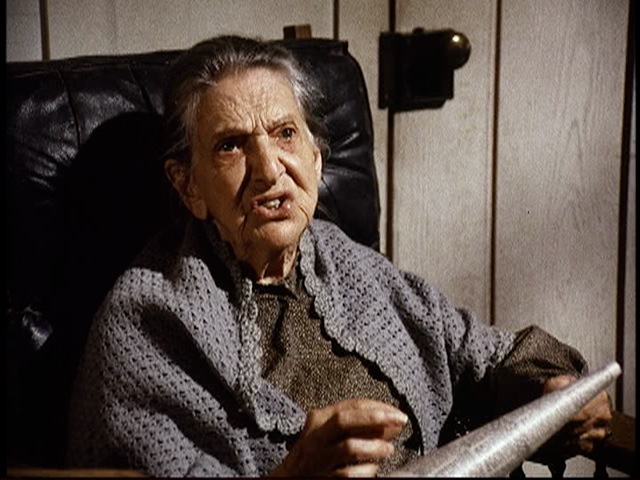
… that the only other time I remember her doing it was in IT’S A WONDERFUL LIFE in the scene where the James Stewart character saw her as she would have been if he had not lived. She wasn’t playing a mountain woman, but she was portraying a cantankerous, unhappy old woman.
I heard rumored at the time that Michael Learned had an arrangement with the writers that if she didn’t have dialogue in a scene, she was not to be included. I sympathize with actors in supporting roles in series who are not always used to best advantage, who are just wasted. (i.e. Joan Blondell in BANYON, Burgess Meredith in SEARCH, Phil Abbott in THE FBI). What I think Michael didn’t appreciate was the power of her mere presence in a scene.
The night THE PONY CART aired, Beulah had a small dinner party for friends, who would then watch the show with her, Mary Jackson (one of the Baldwin sisters), Amzie Strickland and some others. I was invited but could not attend because I was finishing filming an episode of FAMILY. I was told that during the “planting” scene you just viewed, Beulah exclaimed, “She’s stealing the scene!” Mary Jackson reassured her, “No she’s not stealing the scene, Beulah.”
Ed Graves (art director) and I scouted the locations in Frazier Park for this production. It was far simpler than it had been for THE CONFLICT. We only needed two sites — the place where the home had stood and the graveyard; and it would only be for one day, no overnight. Only Beulah and Richard would be performing. As we started back, Ed spotted a rattlesnake in the middle of the road. I don’t think I had ever seen a rattlesnake before, and no, we didn’t get out of the car to look at it. Ed rode over it, crushing it beneath the tires, as he maneuvered the car back and forth, back and forth. We then went to the ranger station to report the location of the remains.
In the editing a cut was made in that scene:
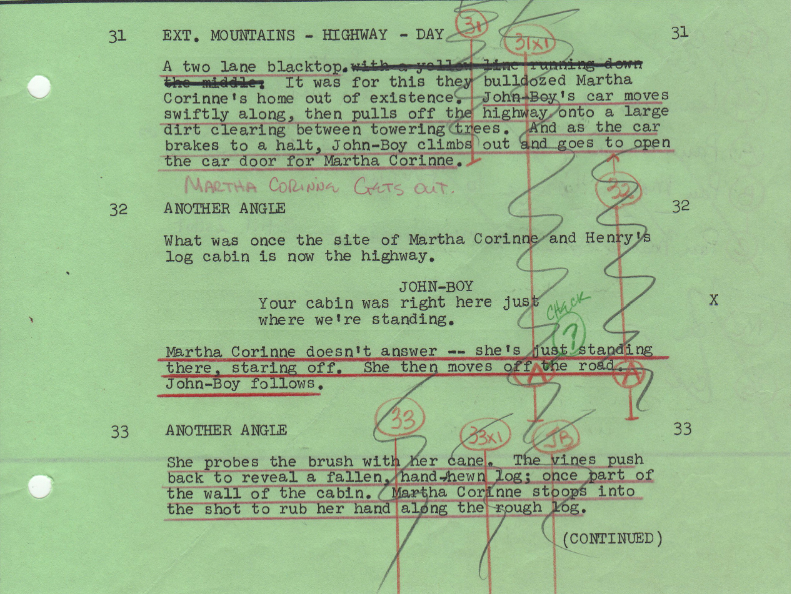
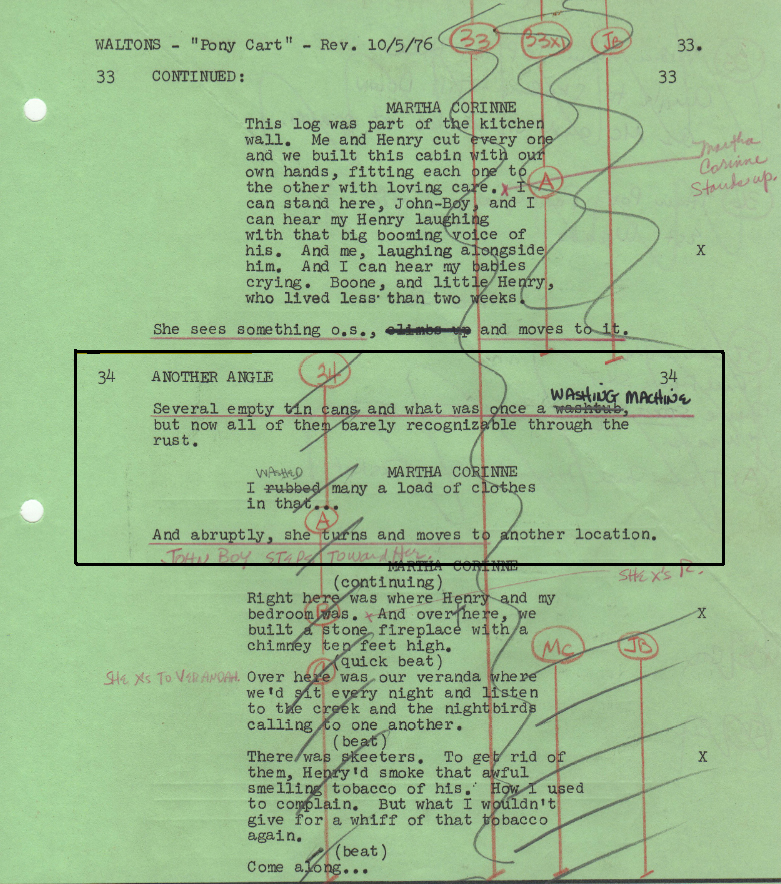
But there was a problem. In the first part of the scene when Martha Corinne said, “This log was part of the kitchen wall …” she was looking camera left …
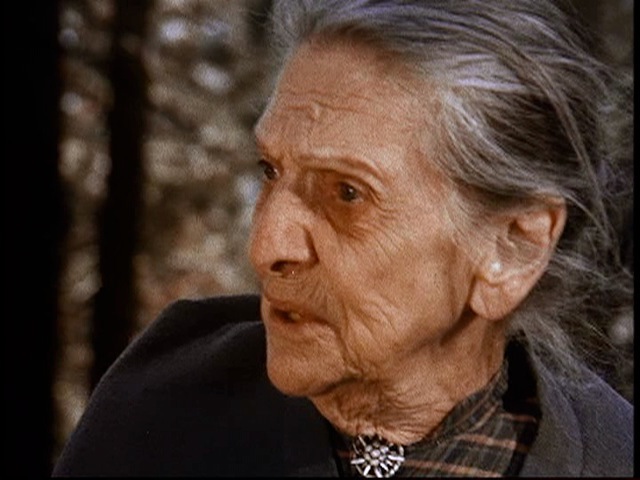
… and at the end of the scene she exited camera left. But in the master shot that came after the cut was made, Martha Corinne was standing far to the right.
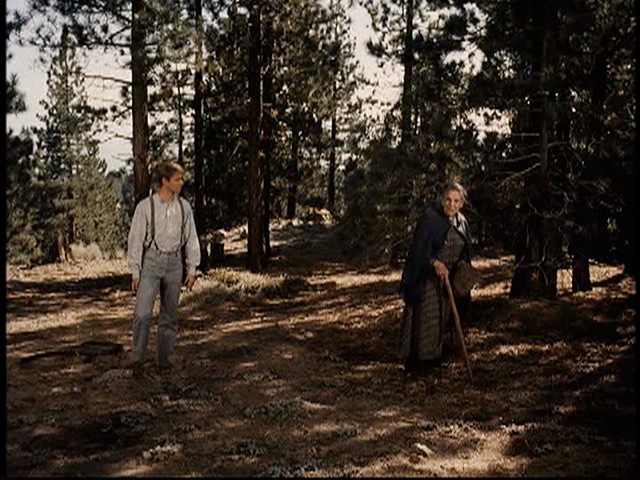
So the shot, starting with her cane tapping the log that tilted up to her closeup was flopped so that she was looking camera right. Because there was no part in her hair, there was no problem doing that. If it had been a shot of John-Boy, that could not have been done.
The small creek where John-Boy went to get water in the rusty can was not filmed in Frazier Park. It was shot on the back lot of Warner Bros. studio. And I vaguely remember that Richard had a sprained ankle when we filmed this sequence. But no complaints or excuses from him. Just two consummate performers at their peak.
“I’d hate to be as stubborn as you are.” Being a Taurus I loved that line. And Beulah was a Taurus. I remember when we went to see Baryshnikov at the Hollywood Bowl, Beulah insisted on paying for the parking, and I insisted she shouldn’t. That line was said that night; I just don’t remember who said it.
The location for the final sequence with Martha Corinne presented a challenge.
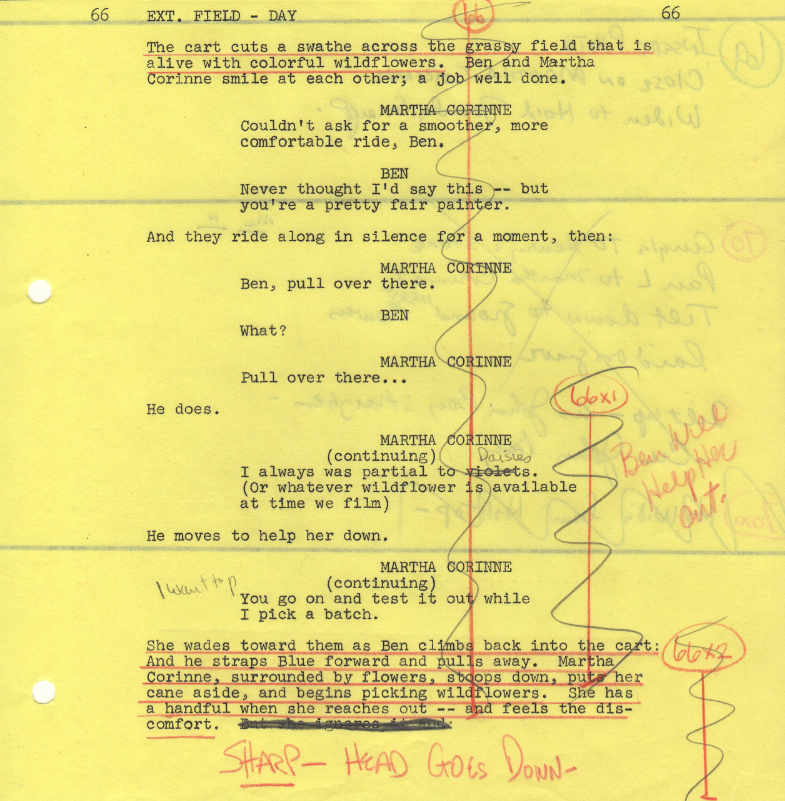
Our only scheduled filming off the lot was Frazier Park, and with the ninety-mile commute to and from, even if we could have found a place to film it on our one day there, lack of time would have prevented it. So Ed Graves, the art director, had to create it on the Warner Bros. backlot. Unlike MGM’s backlot, there were no fields there, much less fields of daisies. It was all wooded areas and dirt roads. So Ed found a place where there was a fork in the road: where the fork led off to the left would be the path for the pony cart; where the fork led off to the right, he created our field of daisies.
Forgotten tombstones are also a shameful thing. I remember that when it came time to shoot them, they weren’t there. I have called on my friend John Dayton, who was a production assistant on the show, to supply the details of what happened, most of which I am finding out for the first time.
Yes, Martha Corinne’s headstone was left behind at the studio, as was I
think one of the others. You were very upset, in fact it was the first time
I heard you say the word f*** – shocking.
Walter Alzmann (production manager-assistant director) in his German-firm-way suggested you shoot the faces of the gravestones on the berm behind the barn at the studio – you said, NO, ABSOLUTELY NOT! — there was a mad scramble — what to do??
I believe it was Ed Graves who suggested that someone drive down the
mountain into Fraser Park to see if a piece of wood could be purchased to
use as Martha Corinne’s headstone — Freddy Westcott drove down the hill, or it might have been Tony Cellucci — miraculously, an hour or so later, a piece of wood was fetched from a local lumber company. It had been cut to look like a headstone. I clearly recall it being a piece of wood of two different shades, and that there was no way to engrave it.
You had to compromise — shooting a panning shot of the front of the graves on the berm that backed up to the house and barn of Walton Flats at the studio — this was the shot that established the fact that the space was there next to Henry for Martha Corinne.
In the show, you cut to that berm shot as Beulah and Richard approach the graves down the hill on the mountain — you then cut back to Beulah and Richard as they come around the graves, and stay on the back of the gravestones for the entire sequence — when you do come around close on Beulah she blocks the stones — the final shot of the show (before the Pony Cart night shot) is Richard on the mountain looking at the graves – showing the back of them — and Beulah’s grave is that piece of wood that was purchased in Fraser Park.
It all works beautifully — and no one knows but us.
At the end of the season Beulah was nominated for an Emmy for her performance.
Film clip is from a recent interview by the Archive of American Television, a division of the Academy of Television Arts & Sciences Foundation.
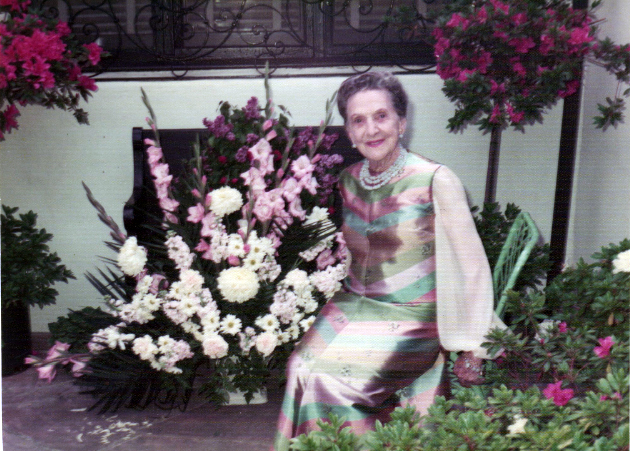
Beulah the night she won the Emmy
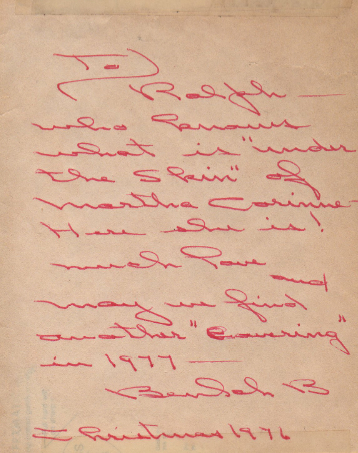
It came with the picture
Irony of ironies, that year Gary Frank won an Emmy for his continuing role in FAMILY. The episode he submitted to the Academy was the one we were filming the night THE PONY CART aired.
What I did not know when THE PONY CART wrapped was that it would be the last time I would work with Richard Thomas. What I also did not know until this very moment (thank you the wonderful IMDB) was the prophetic information that Richard’s middle name was Earl. Richard left THE WALTONS at the end of the fifth season because he had only signed a five-year contract. He continued to work on the west coast, and I saw him star the following year onstage in MERTON OF THE MOVIES at the Ahmanson Theatre. I saw him again onstage almost a decade later when he appeared with John Rubinstein in ARMS AND THE MAN at the Pasadena Playhouse. The two of them gave fine performances in a stunning production. During the run I learned there was going to be a special performance of the play and I attended. Richard and John had decided to SWITCH roles for a single performance and a remarkable performance it was. It was as polished as if they had been playing those roles from the very beginning. Richard has continued to work, onstage and onscreen to this very day. He has grown into adult roles, as was his intent when he left the series. But if the image of John-Boy Walton continues to cling to him, he has no one to blame but himself. Richard was (and is) a remarkable actor. He brought to that role the same dedication, the same meticulous attention to detail that Beulah Bondi did to her work. And doing that on a daily basis over a span of five years in 124 episodes was an enormous endeavor. The result was that he portrayed what I believe is the most complete and definitive portrait of a young boy crossing the threshold into manhood that has ever been recorded on film.
Again I was allowed to alter the usual “Good Night’ ending.
The journey continues



Ralph, watching the clips brought so much more back, although much of that particular episode, as you know, is burned in my memory.
It is remarkable that watching these clips I recall almost ALL of Beulah’s dialogue – that’s what a powerful presence she was – or should I say Martha Corinne was.
For years I used the line “…makes a body wonder what ever happened to quality” — and how about “…we’re listenin’ to swing” — I remember you laughing after we cut — and “…oh what I would give for a whiff of that tobacco today”.
I was a youngster then, and appreciate today what it means to get old, and to lose friends and family — I was moved when Beulah delivered those lines on set — I’m more profoundly moved now.
This film is an amazing legacy to leave for the ages, and Ralph, all I can say is thank you for being the inspiration then, as you are now through this journey.
What a fantastic website! I love all the details that I never knew. As fans, we only see the finished product and don’t realize the hard work involved.
Ralph, out of the many Walton’s episodes (and I’ve seen all of them), I must admit that four of my all time favorites have you involved in directing them.
I have a lot of favorite scenes in this episode, however one of them is Martha cooking sausage! The way she describes making it hot and throwing on the pepper, the sound of it cracking in the frying pan…watching John Boy take a bite. Makes me hungry every single time!
The look on Olivia and Grandma’s face when he actually loves it is priceless.
I love this website!! I’ve wanted a pony cart for a long time and now it’s time…but I cannot find any pictures of the cart to create a replica…any ideas?
thanks
How about making stills of shots of the pony cart in this posting?
I, AM 79 AND ALSO LOOKING FOR A MORE DETAILED, SIDE VIEW. OF THE CART.
I HAVE CLOSED UP THE BUGGY BUSINESS? BEEN DOING THIS SINCE 1972. AS A HOBBY/BUSINESS. THE LAST ONE STILL HERE IS A FULL SIZE HEARSE, COMPLETE EXCEPT FOR THE TONGUE? NOW UNKNOWN WHO WILL PULL IT? WAS TO BE USED FOR MY PASSING, BUT I AM NO LONGER ABLE TO TAKE PROPER CARE OF THE HORSES? WENT FROM BELGAIN’S TO HAFFLINGER’S AND FINALLY THE SMALLER 42″ PONIES.
Don: Go to my post, SPECIAL: The Pony Cart Comes Home at: http://senensky.com/special-pony-cart-comes-home/
That tells the final story of our Pony Cart. The film clip at the end closes with a wonderful side view of the Pony Cart.
Hello
I hope you’re still with us ❤️
I too drive horses
I’m getting tired at the age my father started.
He’s 86 and can’t do what he used to do.
Take care
This is one of the best episodes of a great series. Not only is Beulah Bondi wonderful in it, but I love the message it sends. And I liked Martha Corrinne – she reminded me a bit of my own grandmother, may she rest in peace.
Thanks for posting these wonderful stories, Ralph.
“The Pony Cart” is my favorite episode—I consider it “part 2” of “The Conflict.” Of course, there are about a hundred other episodes that come in a close second, but this is “the one.” I am especially drawn to the mixed emotions of love and sadness that Martha Corinne (exquisitely portrayed by Beulah Bondi) shows in that episode. The message—that remembering and cherishing family history should be central in every person’s life—comes through loud and clear. The touching mixture of tenderness and melancholy leaves me misty-eyed every time.
This is an episode that I am somewhat obsessed with. As a matter of fact, I do not watch this episode without viewing “The Conflict” first. These two episodes present a situation not unlike present times, where people are coping with huge changes in our society due to technology. But there’s more to Martha than that….
After going to IMDB, there are a few remarks about Grandma’s negative behavior in this episode. Naturally, her character has a tendency to be cranky, yet in this episode, Grandma is downright mean – to the point where John Boy has to raise his voice at her.
If anyone was leading the bandwagon to have Martha leave, it was Grandma. If there’s any insight you may have about that part of the script, it would be most appreciated.
Thank you and a Happy Birthday to you tomorrow Ralph!
That was just Grandma as Ellen portrayed her. I never thought of it as being mean behavior. Grandma was the matriarch in the Walton household, and all of a sudden she wasn’t. An older person had arrived, and Martha Corinne was not one to move in quietly. She was strictly a take charge lady. I always thought Ellen’s Grandma was the pepper to counteract the gentle sweetness of the series.
pardon my ignorance. i spoke on the Walton’s page that i wished Mrs. Bondi would have received the emmy for her portrayal of Martha. I did not know she did, but i believe it is one of the best acting performances i have ever seen. and that is my favorite episode. i have pledged to myself to buy the whole series, to watch when i wish. thank you for a great piece. sally van der clock
You are a super talent! I’ve been a fan of yours for years – Star Trek, Twelve O’clock High!, Dr. Kildare….so many others, and of course, The Waltons. “The Pony Cart” develops the characters and motivation so beautifully and gently – it’s the best episode of a very special series. You, Mr. Senensky, are a national treasure.
You have left me speechless, barely able to utter a humble “thank you!”
Ahh, no – it is I who am humbled. Star Trek’s “Metamorphosis”? “Is There In Truth No Beauty?” (despite it’s animation). “This Side of Paradise”? As a baby boomer, I was raised on television drama. You, and a few others, (John Erman, Marc Daniels, and Philip Leacock come to mind), were not the best part of American television of my youth. You WERE American television. And (thank God for film!) still are.
This has always been one of or possibly THE favourite episodes of mine.
It’s funny because I never see Martha Corinne as crabby or unhappy. I saw her as an elderly woman who knew that she had very little time left and had a lot to do in that time. As a result, she didn’t have time to worry about what anyone thought or whether she was stepping on toes. If she was any other woman, she might have accepted the rebuffs of the family and given up.
The scene where she is giving out the presents says it all. She’s matter-of-fact about handing them to the recipient, along with their meaning and their history. She’s giving away the things that have the most meaning in her life and to the person who can appreciate them the most and who she knows will carry the legacy of the items. It is the same with the pony cart. She’s presenting both the past and herself to the family through the cart.
I have always been moved by Beulah Bond’s portrayal of Lucy Cooper in “Make Way for Tomorrow” (a favourite film of mine). In a way, she was the antithesis of Martha Corrine. She can’t win and when she tries to make herself useful or tries to impart wisdom and is rebuffed by the family, she demures and retires. I wanted to kick the family…
The Pony Cart is about bringing the past with you into the future. Make Way is about tossing the past aside.
John Springer in his magnificent book, THEY HAD FACES THEN, which he dedicated to Beulah Bondi, wrote, “The year the Academy did not nominate Beulah Bondi’s performance in MAKE WAY FOR TOMORROW was the year the Academy Award failed to have any significance. ( I may not be quoting exactly, but the meaning of what he said is there)
Hi Ralph,
Long time. Hope you are doing well.
It’s “Tom Wheeler” from The Pony Cart. How are you? I was over at Warners the other day and they have put signs on each of their sound stages telling what Film or TV project was shot there and I saw the one that we filmed The Pony Cart interior on. It brought back memories. It was a great shoot and you were terrific to work with. Also, I’ve always considered it a great honor to have worked with Ms Bondi who worked with Lionel Barrymore, Cary Grant, Jimmy Stewart and so many others. I believe it was her last show,
wasn’t it? We did exchange a couple of cards later.
Saw your blog, so I wanted to say hello and thank you for allowing me to be part of a truly lovely, poignant and lasting piece of TV history.
All the best,
Patrick
THE COMPLETE WALTON SHOW, BRING BACK MEMORIES. WITH THE PASSING OF MY MOTHER AT 11 YEARS OLD. THEN LIVING WITH MY GRANDMOTHER. ON A DAIRY FARM, FARMING WITH 3 TEAMS OF HORSES, TO RUN IT.
AND THE CART THAT WAS UP IN THE HAY LOFT. THIS COULD HAVE BEEN THE DREAM I ALWAYS HAD? THIS IS ONE SHOW THAT HOLDS THE CLEAN, BUT REALIST, LIFE THAT I CAN SIT, AND REMEMBER. AND THAT I ALLOWED MY 8 STEP CHILDREN TO WATCH.
THANKS FOR SUCH MEMORIES, DON
Hi Ralph,
I’m currently working on reproducing Martha Corinne’s plaid dress outfit from “The Pony Cart”, and your wonderful site has been most helpful, indeed. Thank you so much for sharing.
I’ve finally finished the dress and am uploading videos of the process. I’ve made a playlist of the progress of this project, for any who may be interested: https://youtube.com/playlist?list=PLhJd3FJFTt6vF8zgGBfO__2CmEtSYaqI6
Once again, thank you so much for sharing your insight into The Waltons, The Pony Cart, The Conflict, and Beulah, here, Ralph. Very much appreciated, indeed. Take care. 🙂
Pingback: SPECIAL: Why I Loved Directing The Waltons - Ralph's Cinema TrekRalph's Cinema Trek
I really enjoy seeing the printed script with the director’s notes, and being able to compare it with the performances we saw on the screen. Thank you!!
Dear Ralph- this episode aired last night on a cable station . I hadn’t watched this series since it’s original run, when I was a teenager. But seeing Beulah’s powerful performance shook me to the core. In my sixties now, her speech about how the hardest part of growing old was the loss of family and friends moved me so deeply. It’s something that’s on my mind often, as it’s happening more and more. And the ache in her voice brought me to tears.
So beautifully directed – the montage scene near the end was wonderful. I would definitely it this episode of the series in their top 5 !
Thank you for the lovely memories of your time with Beulah, on and off camera.
Best, Karen
Are you the Karen who interviewed me 12 years ago?
I wish I was ! I’m just a fan who recently discovered your blog. I wrote you a comment about that a few months ago on the blog page for “This Side of Paradise”